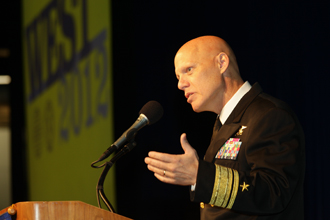The Devil Is in the Details for Future Defense Planning
West 2012 Online Show Daily: Day 2
Quote of the day: “We’ve entered a new budget environment where you can have anything you want, but you can’t have everything. You have to make the choices.” —Lt. Gen. George J. Flynn, USMC, director, J-7, the Joint Staff
Where Day 1 of West 2012 in San Diego focused on the inevitability of defense budget cuts, Day 2 broke down some of the disciplines that will be the focal point of difficult decisions in the coming months. Capabilities ranging from information security to nuclear submarines came under expert scrutiny as speakers and panelists tried to anticipate the changes that lie ahead and offer solutions to the challenges that are emerging.
 |
| Rear Adm. Sean A. Pybus, USN, the commander of the U.S. Navy Special Warfare Command, describes the future of special operations during his plenary address at West 2012. |
Adm. Pybus noted that the NSW is engaged in winning the war with the Taliban in Afghanistan village by village. These village stability efforts involve helping train local constabulary and fighting the Taliban, who oppose those efforts. “The Taliban are not happy about this strategy to invest at the village and local level,” the admiral stated.
Most of the NSW’s 2,100 deployed personnel are in Afghanistan, and their efforts will take years to succeed fully. These U.S. special forces are building trust among the people, and that effort is working, he offered.
“Our hand is extended to shake hands with trust, not with a knife in it,” Adm. Pybus declared.
Continuing successful NSW operations worldwide will require new technologies, some of which the admiral described to the audience. These include better intelligence, surveillance and reconnaissance sensors, payloads and platforms. The command also needs to be able to communicate in a contested environment anywhere in the world, including through adversary electronic warfare. Individual soldier systems for personal self defense and a “thick network” to serve small groups in hostile areas also are on the commander’s wish list.
Many of these technologies will be necessary because the conventional force drawdown will hinder NSW operations. Adm. Pybus explained that SOFs routinely use conventional force capabilities such as communications networks, medical care and other support activities. Absent those conventional forces, the NSW will need those capabilities itself, he pointed out.
Hard decisions will need to be made throughout the military. Lt. Gen. George J. Flynn, USMC, director, J-7, the Joint Staff, told the Wednesday luncheon audience that the military must do what it needs to do by using what it has.
“We’ve entered a new budget environment where you can have anything you want, but you can’t have everything. You have to make the choices,” he stated.
Gen. Flynn supported Adm. Pybus when it came to the role of SOFs, saying that special operations types of capabilities will be important. The general also warned that adversaries may turn out to have the most cost-effective approach to warfare as they seek an adaptive advantage through asymmetry.
The general added that some vulnerabilities in the U.S. military may lie in its processes, which an enemy will exploit. Acquisition was the topic of the day’s three panels, which covered topics ranging from shipbuilding to information security.
Panelists discussing information security largely agreed that risk must be weighed against cost for future military security procurements. Not only must planners consider that basic tradeoff for incorporating security, they also must do battle with an outmoded acquisition system and new capabilities that are changing the nature of the cyber threat.
Department of the Navy Chief Information Officer Terry Halvorsen admitted that no one—whether in government or in industry—is good at truly quantifying the cost effectiveness of security measures. Neither does the government know exactly what it spends on accreditation certification, but that amount is growing every day, he noted.
Rear Adm. Patrick H. Brady, USN, commander, Space and Naval Warfare Systems Command, added that security customers need to be sure that they are buying the right products. He called for a move away from the consumption mindset in which organizations are incentivized to spend their allocated funds. In addition to focusing on combat readiness, security acquisition efforts also must have the correct contracting strategies and can sustain competition throughout the lifetime of the product.
In terms of overall technology acquisition for the warfighter, experts on another panel called for industry to “keep it simple and reliable,” as stated by Brig. Gen. Gregg A. Sturdevant, USMC, assistant wing commander, 3rd Marine Aircraft Wing.
Rear Adm. Jerry K. Burroughs, USN, program executive officer for C4I, outlined a technology wish list that includes changes in traditional approaches. The government will want full data rights for whatever industry is developing, he stated, adding, “The days of government not getting proprietary data rights are over.”
Wish list items listed by Adm. Burroughs include improved two way communications with steerable antenna beams and multibeam antennas; network management technologies for operating in degraded environments; and robust, modular, scalable computer capabilities. Foremost is information assurance, which the admiral described as having an exploding number of requirements to keep networks secure. “If we don’t get our arms around that, we will never be able to afford to keep our networks secure,” he warned.
On Day 3 of West 2012:
An address by Undersecretary of the Navy Robert O. Work, a conversation with David Hartman and a recent Congressional Medal of Honor recipient, and panel discussions on junior warfighters and China.




Comments